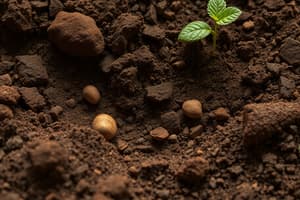Podcast
Questions and Answers
What does soil texture refer to?
What does soil texture refer to?
- The color of the soil
- The consistency of the soil
- The temperature of the soil
- The relative proportion of sand, silt, and clay in the soil (correct)
Which method involves rolling soil into a thread to determine its texture?
Which method involves rolling soil into a thread to determine its texture?
- Texture Analysis
- Feel Method
- Roll Method (correct)
- Sedimentation Method
How is soil texture determined using the 'Feel Method'?
How is soil texture determined using the 'Feel Method'?
- By rubbing the material with fingers to feel its texture (correct)
- By measuring the temperature of the soil
- By observing the color of the soil
- By tasting a small sample of the soil
What are the three soil separates classified based on particle size?
What are the three soil separates classified based on particle size?
What is the purpose of the Textural Triangle?
What is the purpose of the Textural Triangle?
In the context of soil science, what is meant by 'soil separates'?
In the context of soil science, what is meant by 'soil separates'?
'Soil texture' may feel soft, coarse, smooth, powdery or sticky depending on:
'Soil texture' may feel soft, coarse, smooth, powdery or sticky depending on:
'Each separate' in soil science refers to:
'Each separate' in soil science refers to:
'Bulk and Particle Densities' are classified under which category of properties in soils?
'Bulk and Particle Densities' are classified under which category of properties in soils?
'Aeration' is a property of soils related to:
'Aeration' is a property of soils related to:
Flashcards
Soil Texture
Soil Texture
The relative proportion of sand, silt, and clay in the soil.
Soil Separates
Soil Separates
Distinct particle size ranges, such as sand, silt, and clay.
Three Soil Separates
Three Soil Separates
Sand, silt, and clay.
Feel Method
Feel Method
Signup and view all the flashcards
Roll Method
Roll Method
Signup and view all the flashcards
Textural Triangle Purpose
Textural Triangle Purpose
Signup and view all the flashcards
Each Separate
Each Separate
Signup and view all the flashcards
'Bulk and Particle Densities'
'Bulk and Particle Densities'
Signup and view all the flashcards
'Aeration'
'Aeration'
Signup and view all the flashcards
Soil texture depends on
Soil texture depends on
Signup and view all the flashcards
Study Notes
Soil Classification
- Soils can be classified into 12 textural classes or grades, including sand (85% sand or more), loamy sand (75-85% sand), coarse-textured soils, sandy loam (43-52% sand), loam (less than 52% sand, 7-27% clay, 28-50% silt), silt loam (less than 50% silt), medium-textured soils, clay loam soils, sandy clay loam, silty clay loam, sandy clay, and fine-textured soils.
Soil Texture Determination
- Soil texture can be determined in three ways: by feel method, roll method, and by mechanical analysis.
- The feel method involves rubbing moist soil between the fingers to estimate the characteristic "feel" of the dominant soil separate.
- The roll method involves kneading a moist soil sample into a rod to approximate the soil texture.
- Mechanical analysis is a more accurate method that involves separating soil particles into different size fractions.
Soil Properties
- Soil properties can be classified into three categories: physical, chemical, and biological.
- Physical properties of soils include soil texture, color, consistency, temperature, structure, densities and porosity, and water/soil moisture and aeration.
Soil Separates
- Soil particles can be grouped into three soil separates: sand, silt, and clay.
- Each separate has a specific range of particle sizes, and they are often referred to as fractions (e.g., sand fraction, silt fraction, or clay fraction).
- The characteristics of each separate affect the overall properties and behavior of the soil.
Characteristics of Soil Separates
- Sand: low water-holding capacity, good aeration, high drainage rate, low compactibility, and low surface area.
- Silt: medium to high water-holding capacity, moderate aeration, slow to medium drainage rate, medium compactibility, and medium surface area.
- Clay: high water-holding capacity, poor aeration, very slow drainage rate, high compactibility, and high surface area.
Studying That Suits You
Use AI to generate personalized quizzes and flashcards to suit your learning preferences.



